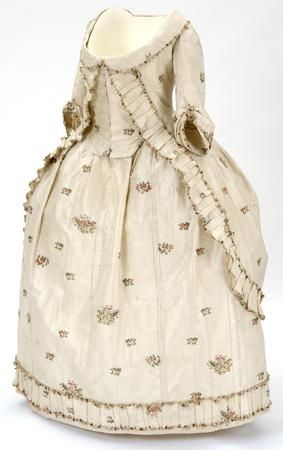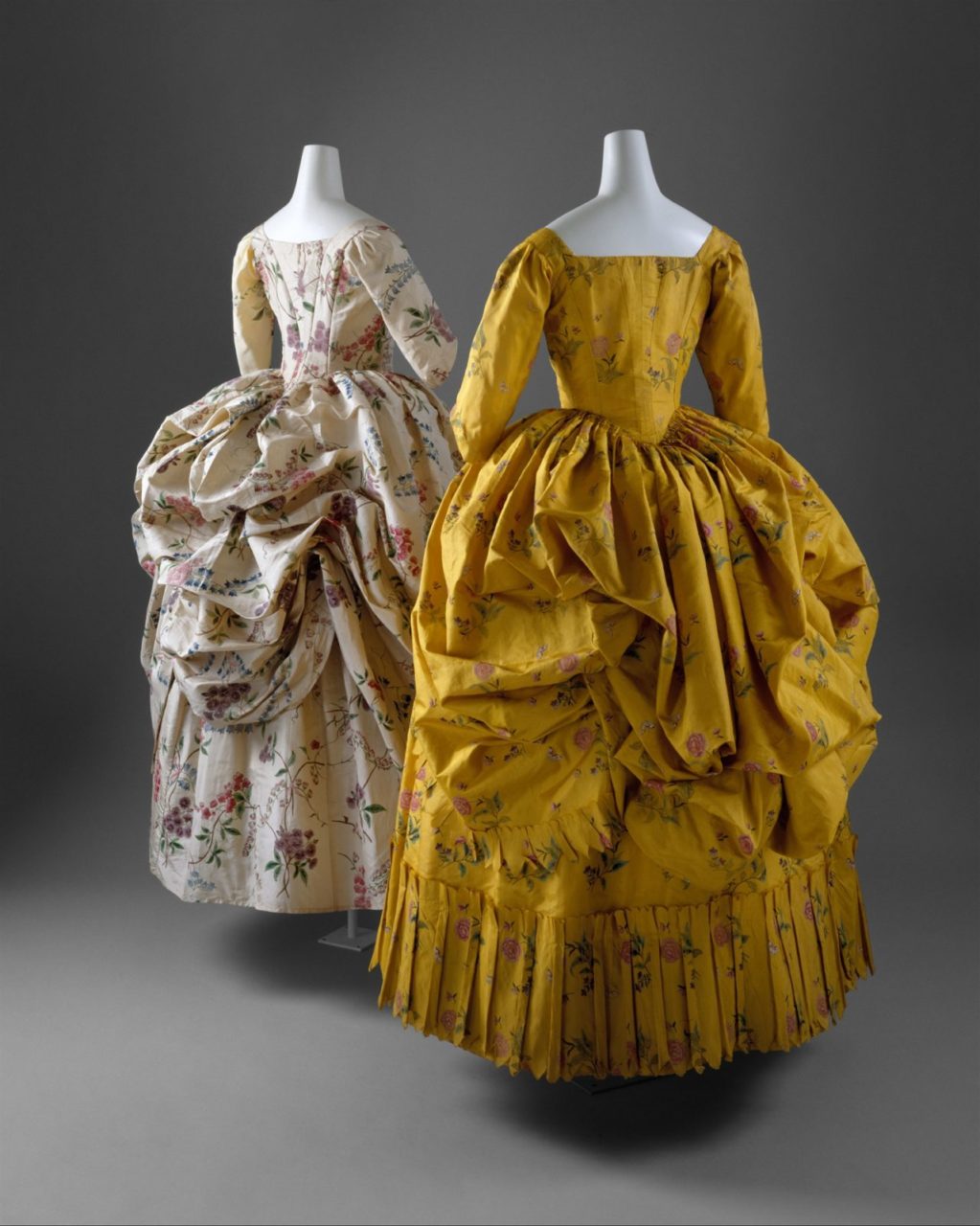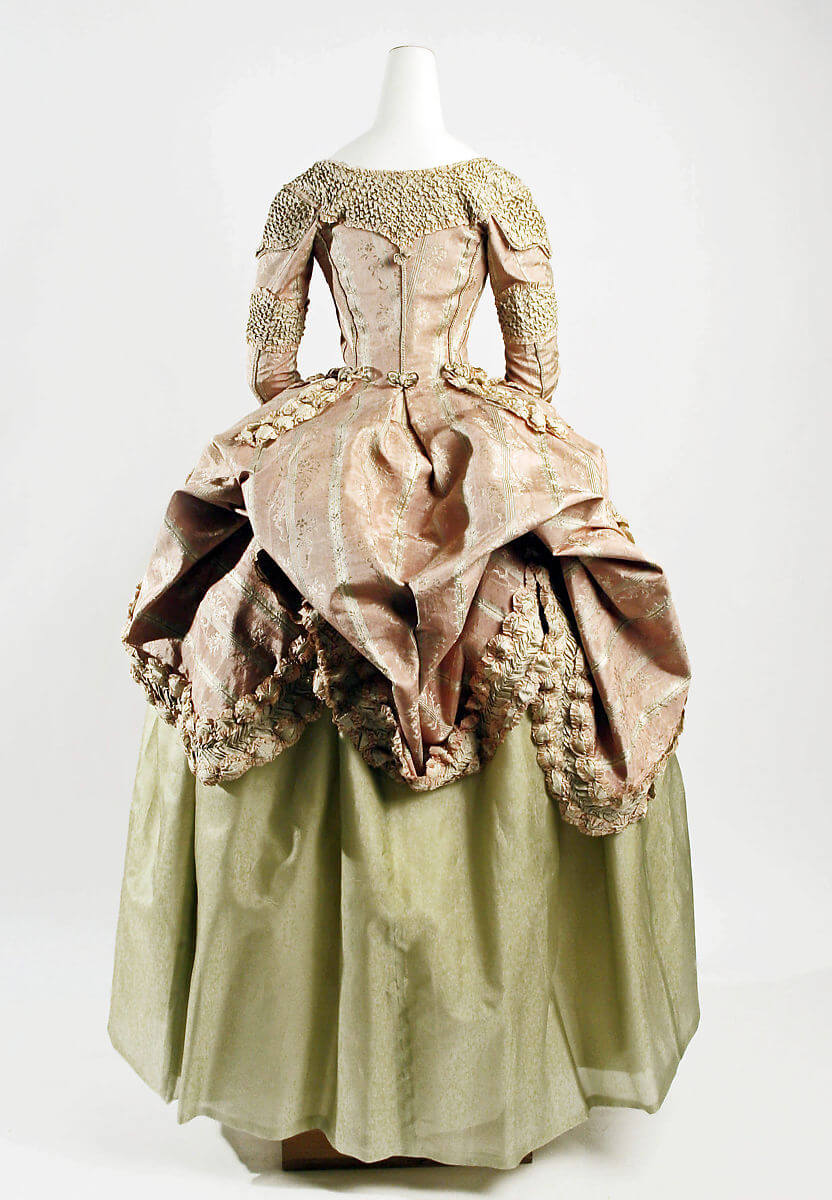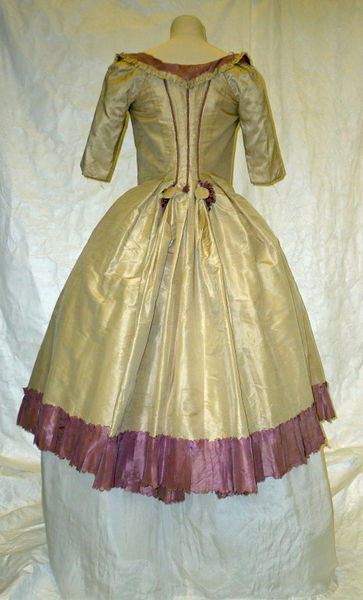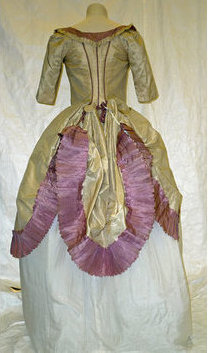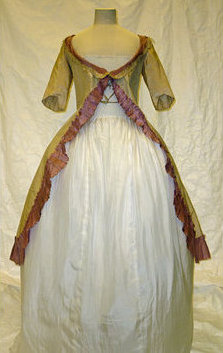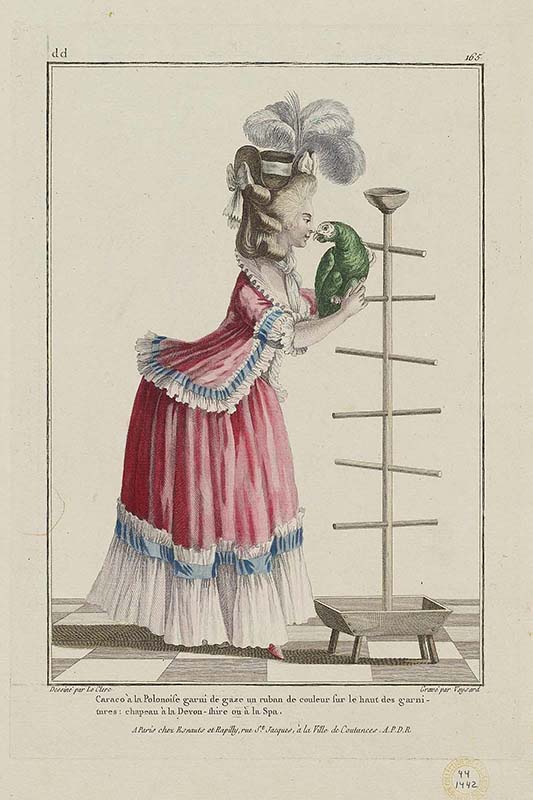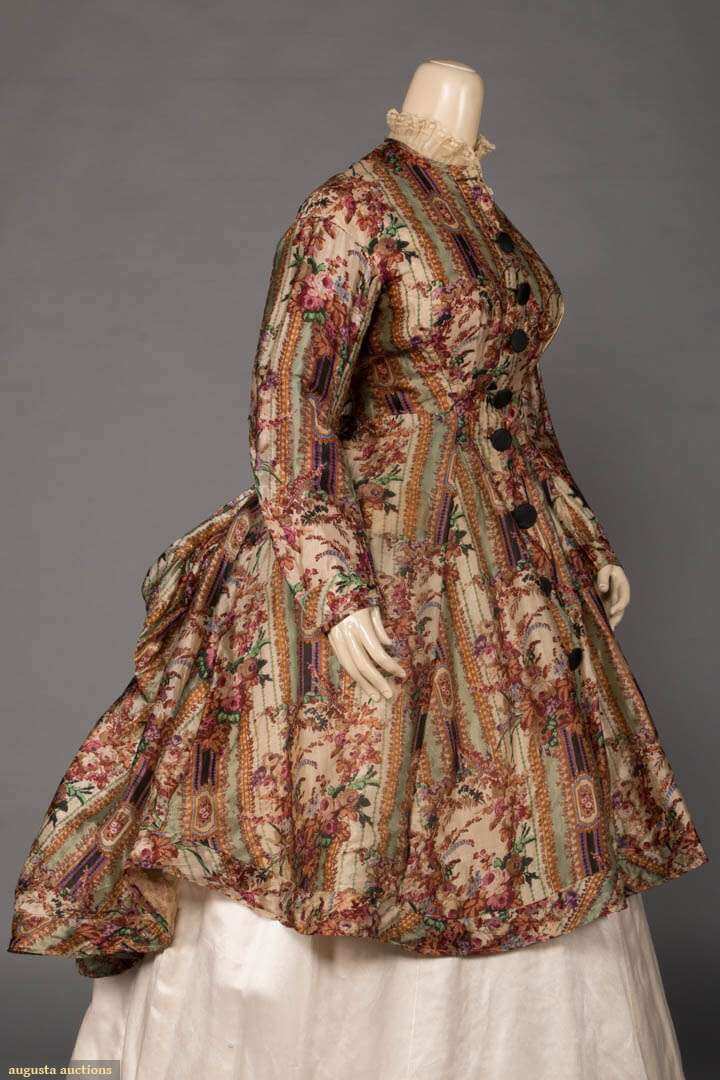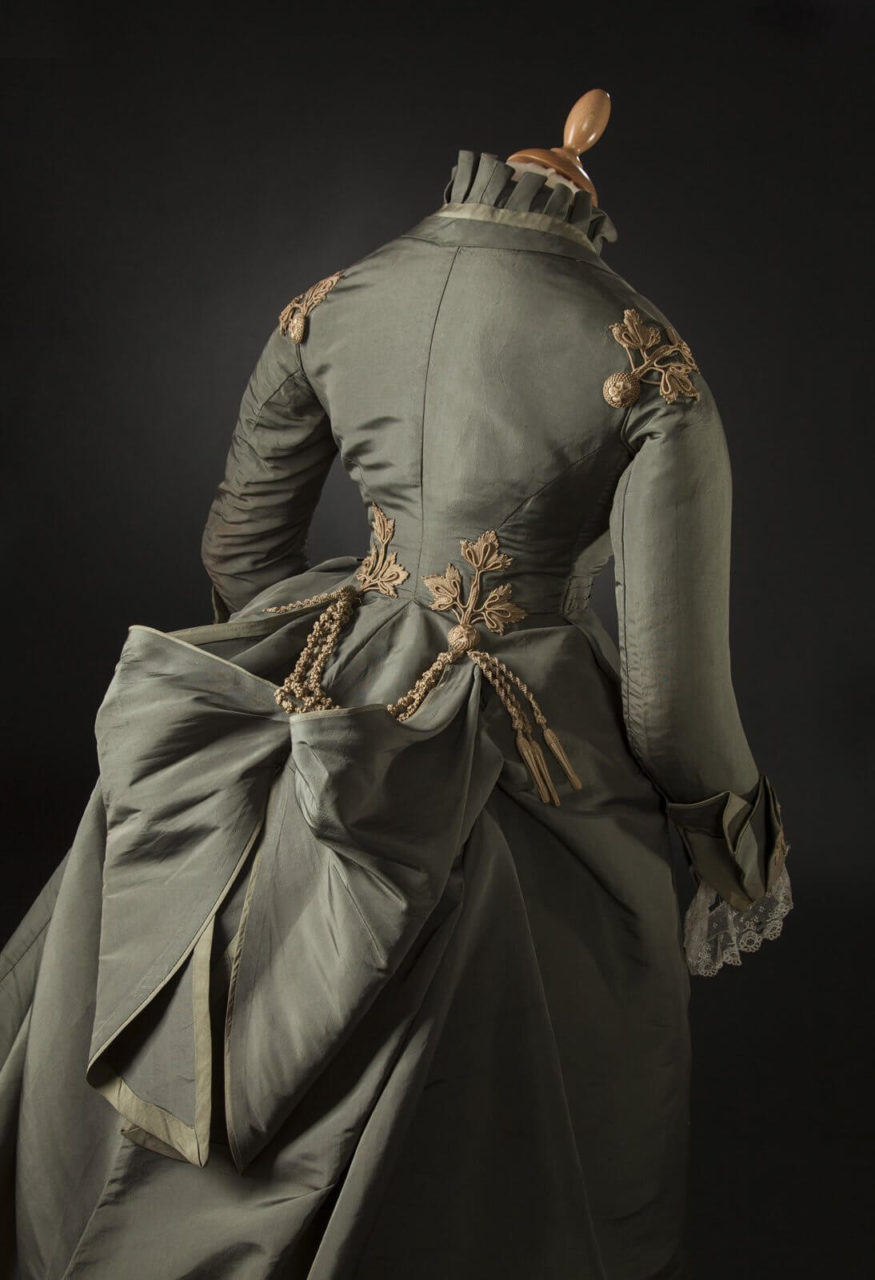A style of dress popular in the 1770s-80s, with a bodice cut all in one and often with the skirts looped up. The polonaise also came back into fashion during the 1870s.
The Details
The polonaise (Fig. 1) is a style of gown that has had several definitions across the centuries. Many fashion historians use the Victorian-era definition, which is correct for the late nineteenth century but not for gowns from the eighteenth century. Unfortunately, this definition will feature in most encyclopedias and books on the Georgian era.
In their article “Eighteenth-Century Clothing” in Fashion, Costume, and Culture: Clothing, Headwear, Body Decorations, and Footwear Through the Ages (2013), Sara Pendergast et al. describe a style that some, but not all, polonaise gowns used:
“Polonaise style referred to the arrangement of the overskirt of a dress into three bunched swags to give the hips the impression of width and to display the petticoat underneath. Derived from a Polish style, the word polonaise means ‘Polish,’ and to wear a dress in this manner was referred to as à la polonaise. (This was done in order to distinguish it from other styles of the time period, such as an English style of wearing dresses, referred to as à l’anglaise.) Polonaise style featured ankle-length petticoats that revealed high-heeled walking shoes.”
Many gowns in museum collections today that are labeled polonaise are actually the other kind they mention, robes à l’anglaise (‘English gown’) (Fig. 2). The primary distinction is that English gowns have a waist seam at the back, where polonaise gowns are cut all in one piece (Van Cleave 1). Note the lack of a waist seam on the gown in figure 3.
While many polonaise gowns did have the skirts looped up, this was also done on sack-back and English gowns, and was generally referred to as retroussée style in France (Van Cleave 5). Additionally, the claim that the polonaise style specifically featured ankle-length skirts is also misleading, as most styles in the 1770s and 1780s were that length.
In How to Read a Dress (2015), Lydia Edwards correctly sums up the polonaise as:
“The robe a la polonaise (“Polish” gown, named for the partition of Poland in 1772…) came in the shape of an open robe with a bodice cut in one piece, the overskirt parted in front to reveal a decorated petticoat. The gown would be looped up in decorative swags using hidden or displayed drawstrings, a practice often referred to as retroussee in contemporary French sources. The introduction of this rather elaborate sounding garment actually heralded a more relaxed and “rustic” way of approaching dress.” (46)
Fig. 1 - Designer unknown (Scottish). Woman's dress, circa 1779-1781. Silk, linen, hand-stitched. Glasgow Museums, 1932.51.h-i. Gift of Mrs Anne D Houston, 1932. Source: This is Versailles
Fig. 2 - Designer unknown (French). Robe à l'anglaise retroussée, ca. 1780. Silk. New York: The Metropolitan Museum of Art, 1976.146a, b. Purchase, Mr. and Mrs. Alan S. Davis Gift, 1976. Source: MMA
Fig. 3 - Designer unknown (French). Dress, 1778-80. Silk. New York: Metropolitan Museum of Art, C.I.60.40.3. Purchase, Irene Lewisohn Bequest, 1960. Source: MMA
Fig. 4 - Designer unknown (French or British). Polonaise, 1775-1780. Silk, linen; 96 cm bust. London: Victoria and Albert Museum, T.20-1945. Source: VAM
Fig. 5 - Designer unknown (French or British). Polonaise, 1775-1780. London: Victoria and Albert Museum, T.20-1945. Source: VAM
Fig. 6 - Designer unknown (French or British). Polonaise, 1775-1780. Silk, linen; 96 cm bust. London: Victoria and Albert Museum, T.20-1945. Source: VAM
A gown from the Victoria and Albert museum is shown in three views in figures 4, 5, and 6 – the skirt is let down normally in figure 4 and looped up to the back buttons (retroussée) in figure 5. The bold trim exaggerates the three drapes. Figure 6 shows the front of the same gown and another aspect of the polonaise style: the inverted V-shape of the front bodice. Polonaise styles could also have much shorter bodices, in the caraco (Fig. 7) or camisole style, but they were rarely looped up in the back and can be harder to identify.
In their article “’Very Much the Taste and Various are the Makes’: Reconsidering the Late-Eighteenth-Century Robe à la Polonaise” (2013) Kendra Van Cleave and Brooke Welborn explain that the cut of the bodice was crucial:
“Polonaises seen in eighteenth-century sources nearly all featured an over-gown or jacket constructed of four pieces (two backs and two fronts) cut without a waist seam… On all depictions studied, the robe met center-front at the neckline; most of the gowns sloped away from this point in an inverted “V” shape, although a few closed further down towards the waistline (but still angled away from that point). This created a loose fit where the sides of the robe were allowed to stand away from the torso. Commonly, one to three pleats at the side back drew the robe in towards the body.” (5)
In the Survey of Historic Costume (2015), Phyllis G. Tortora and Sara B. Marketti follow the nineteenth-century definition even though they are discussing the earlier style:
“fashionable from about 1770-1785… an overdress and petticoat in which the overskirt was puffed and looped by means of tapes and rings sewn into the skirt. A hoop or bustle supported the skirt. In subsequent periods the term polonaise will be used very broadly to refer to any overskirt that is puffed or draped over an under layer.” (288)
The polonaise dress of the nineteenth century was especially popular in the 1870s, and could refer to a long overbodice cut all in one piece (Fig. 8) or a gown featuring bustled swags on its overskirt (Fig. 9). In Fashions of the Gilded Age (2004), Frances Grimble describes the revival of the polonaise in the 19th century:
“The third type of was the polonaise, which was worn over a skirt as an alternative to a separate bodice and overskirt. Some polonaises were shorter princess dresses. These were pleated up in a variety of ways. Other polonaises were bodices with the overskirt attached… The inspiration for these particularly when combined with a square neckline and elbow length ruffled sleeves, was 18th century.” (2)
Fig. 7 - Pierre-Thomas LeClerc (French, about 1740–after 1799). Caraco à la Polonaise garni de gaze..., 1780. Hand-colored engraving on laid paper; 35.6 x 24.1 cm (14 x 9 1/2 in.). Boston: Museum of Fine Arts, 44.1442. The Elizabeth Day McCormick Collection, to MFA 1944. Source: MFA
Fig. 8 - Designer unknown. Polonaise bodice, Early 1870s. Silk gauze; (b 36", w 26.5", l 40-44.5" in). Bellows Falls: Augusta Auctions, SPRING 2020 - Historic Fashion Online, Lot 2. Source: Augusta Auctions
Fig. 9 - Charles Frederick Worth (French, 1825-1895). Afternoon dress, 1870-72. Silk. Paris: Tessier-Sarrou, Objets d'art sale 4 December 2019, lot 213. Source: Tessier-Sarrou
References:
- Edwards, Lydia. How to Read a Dress: A Guide to Changing Fashion from the 16th to the 20th Century. London: Bloomsbury Academic, 2017. http://www.worldcat.org/oclc/1050028879.
- Pendergast, Sara, Tom Pendergast , Drew D. Johnson, and Julie L. Carnagie, eds. “Eighteenth-Century Clothing.” In Fashion, Costume, and Culture: Clothing, Headwear, Body Decorations, and Footwear through the Ages. 2nd ed. Gale Virtual Reference Library. Detroit: UXL, 2013. Gale Online (subscription required)
- Grimble, Frances, ed. Fashions of the Gilded Age. 1st ed. San Francisco, CA: Lavolta Press, 2004. http://www.worldcat.org/oclc/58846647.
- Tortora, Phyllis G., and Sara B. Marcketti. Survey of Historic Costume. Sixth edition. New York: Fairchild Books, 2015. http://www.worldcat.org/oclc/910929404.
- Van Cleave, Kendra, & Brooke Welborn. “Very Much the Taste and Various are the Makes”, Dress 39:1 (2013), 1-24, https://doi.org/10.1179/0361211213Z.0000000008 (subscription required)


